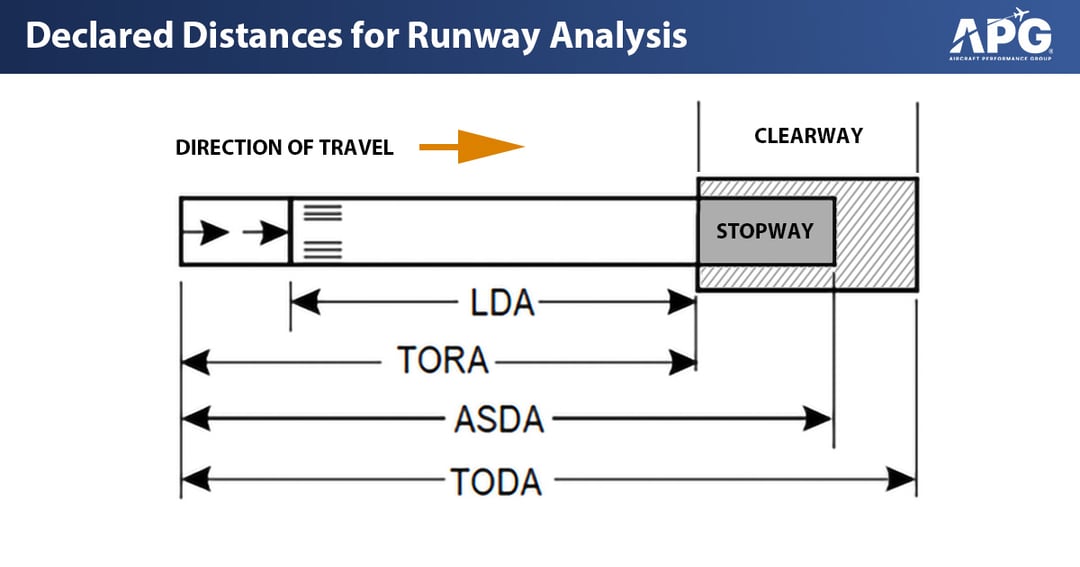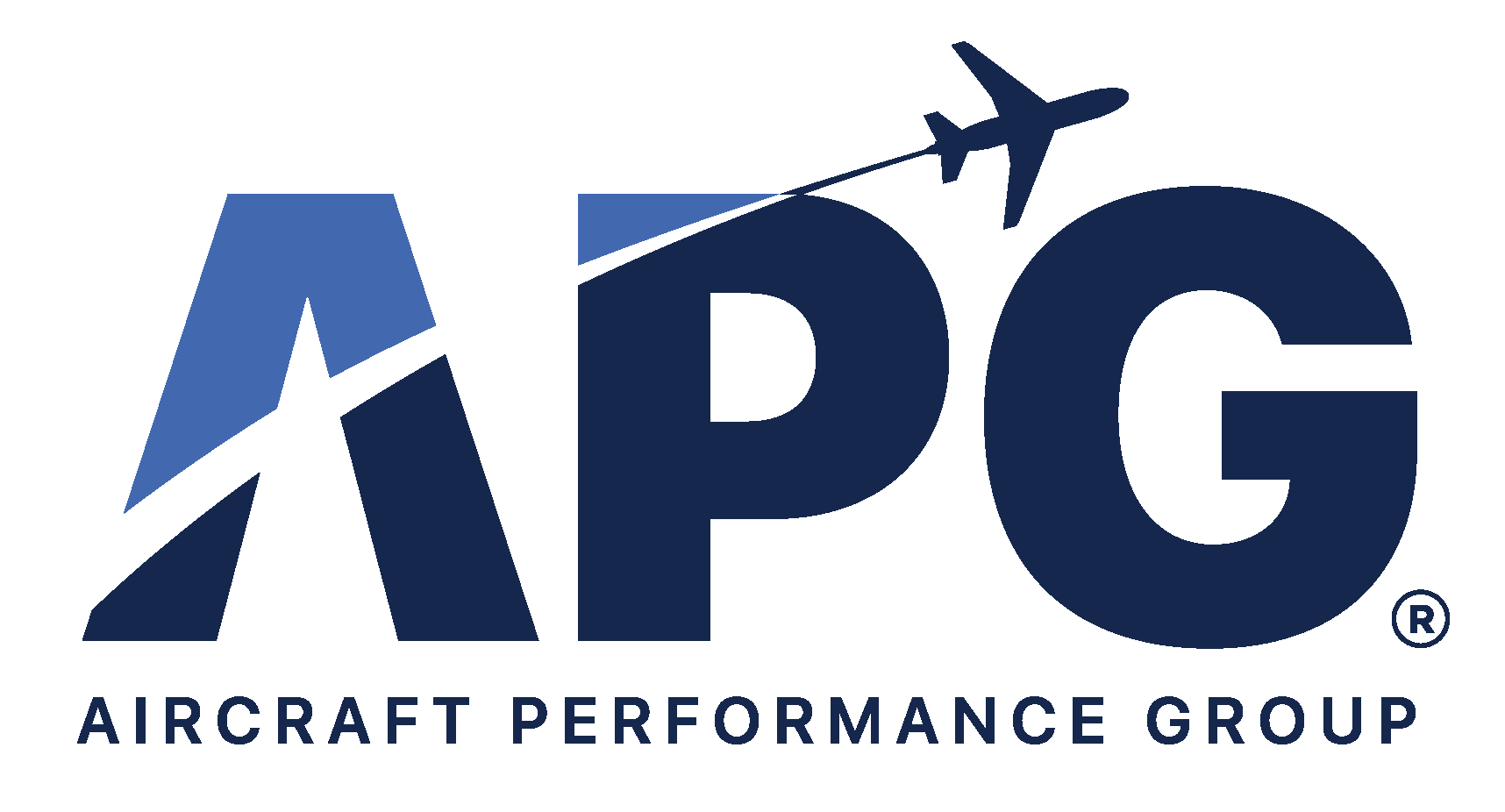
The runway for an aircraft to safely take off and land is dependent on many factors, as part of the flight planning and runway analysis procedures. The declared emergency stopping distance, climb gradient, aircraft weight, bank angle, etc, are all critical performance measurements used to determine the safety margins for aircraft to use a given airport.
What are declared distances?
Declared distances represent the maximum distances available and suitable for meeting takeoff, rejected takeoff, and landing distances performance requirements for aircraft. The declared distances in aviation are:
- Take-Off Run Available (TORA)
- Take-Off Distance Available (TODA)
- Accelerate Stop Distance Available (ASDA)
- Landing Distance Available (LDA)
Take-Off Run Available (TORA)
TORA is the total length of runway available for an aircraft to accelerate from brake release to liftoff and half the horizontal distance to climb to 35 ft. It is effectively the actual length of the prepared surface runway that an aircraft can use for a takeoff roll.
To reach the required takeoff speed, the length of the usable runway must be greater than the takeoff run required for a specific aircraft in prevailing conditions. If the TORA is limited, it may affect the aircraft’s performance, payload, or require changes to the takeoff procedure, which are calculated as part of the preflight process.
For takeoff on wet runways, whether the aircraft is balanced or unbalanced, no clearway is considered. This means the aircraft must achieve the reduced 15 ft screen height by the end of the TORA. In addition, the use of reverse thrust may be considered for wet runway performance.
Take Off Distance Available (TODA)
TODA is the distance to accelerate from brake release, past lift-off, to the start of the takeoff climb to a specified altitude. TODA represents the entire distance that can be utilized for takeoff, including both the paved runway and any clearway beyond the runway.
During take-off, an aircraft must achieve sufficient speed to become airborne and clear any obstacles in its flight path. The takeoff distance required depends on various factors, including the aircraft’s weight, atmospheric conditions, runway surface conditions, and engine performance characteristics. TODA is an essential parameter used by pilots and flight planners during pre-flight calculations.
Accelerate-Stop Distance Available (ASDA)
ASDA applies to a rejected takeoff. Accelerated-Stop Distance Available is the total length of runway available (which may include a stopway) to accelerate from brake release to V1 plus the distance required to safely abort or decelerate to a stop, plus safety factors.
ASDA must consider numerous factors like the aircraft’s performance, runway conditions, aircraft weight, atmospheric conditions, available stopping devices (brakes, reverse thrust).
V1 speed is used as the “decision speed,” which represents the speed at which a pilot must either choose to continue the takeoff or abort in the event of a critical situation. The takeoff decision speed (V1) and the distances to achieve or decelerate from V1 are established by the manufacturer and confirmed during certification testing for varying climatological conditions, operating weights, aircraft configuration, etc.
Can ASDA be shorter than TORA?
Some airports, especially in the United States, have an Accelerate Stop Distance Available (ASDA) that is shorter than the Takeoff Run Available (TORA). This is because the end portion of the runway is not available for accelerate-stop distance calculations, usually as a result of unacceptable land use in the Runway Protection Zone beyond the departure end of the runway. The FAA requires that there be a minimum ‘safety area’ beyond the departure end of the runway that is protected from infringement by items on the ground. This can include roads, buildings, farmland (that does not meet specific requirements), etc. More information can be found in AC 150/5300-13B as to the requirements of this RPZ.
In the case of Teterboro (KTEB), at the time of this writing, there is an ASDA that is 910 ft shorter than the TORA on runway 01. This equates to an ASDA of 6,090 ft. Many charts in print today make no mention of this, and simply show a runway length of 7,000 ft with no restrictions on takeoff distance. This gives the illusion that the full 7,000 ft is available for takeoff, when in fact it is not.
The effect this has on performance will vary depending on whether the aircraft performance data given is balanced or unbalanced. If the aircraft is balanced, the maximum distance allowed for takeoff will be limited by the reduced ASDA. This is because a balanced aircraft by definition will have an accelerate-stop and accelerate-go distance that is equal (in most cases), and thus the calculated field length required must be less than or equal to the Accelerate-Stop Distance Available. If the aircraft is unbalanced, the aircraft must have an accelerate-stop distance that is shorter than the ASDA, but the accelerate-go distance may exceed the ASDA. The maximum distance allowed for accelerate-go will be the TORA plus any clearway, up to the maximum clearway allowed. Refer to the above FAQ for further clarification on the use of clearways.
At the time of this writing, over 250 airports in the United States have an ASDA that is shorter than the TORA. Some of the larger airfields include, but are not limited to:
- Anchorage Intl (PANC)
- Prescott (KPRC)
- Fresno Intl (KFAT)
- San Diego Intl (KSAN)
- San Francisco Intl (KSFO)
- Miami Intl (KMIA)
- Orlando Intl (KMCO)
- Tampa Intl (KTPA)
- Atlanta Intl (KATL)
- Savannah/Hilton Head Intl (KSAV)
- Honolulu Intl (PHNL)
- Chicago O’Hare Intl (KORD)
- Peoria Intl (KPIA)
- Minneapolis St. Paul Intl (KMSP)
- Louis Intl (KSTL)
- Teterboro (KTEB)
- McCarran Intl/Las Vegas (KLAS)
- Albany Intl (KALB)
- Niagara Falls Intl (KIAG)
- Rochester Intl (KROC)
- Philadelphia Intl (KPHL)
- Pittsburgh Intl (KPIT)
- Dallas Love (KDAL)
- Gen Mitchell Intl/Milwaukee Intl (KMKE)
- Cheyenne Regl (KCYS)
Optimized for the aircraft
TORA, TODA, and ASDA can vary by airport. The required declared distances are determined by the aircraft data that will be attempting a takeoff or landing on that specific runway.
Balanced aircraft
In a balanced field length aircraft, the performance data does not differentiate between accelerate-stop and accelerate-go distances. If the aircraft is balanced, the maximum distance available for takeoff, whether the takeoff is continued or rejected, is the lesser of the TORA, TODA, and ASDA. Since the accelerate-go and accelerate-stop distances are balanced, and thus equal to the field length required, exceeding any one of these three values would result in a longer field length required than available.
Unbalanced aircraft
In an unbalanced field length aircraft, the accelerate-go and accelerate-stop distances are evaluated separately, as a function of the V1/VR ratio, and thus can be optimized for the scenario. If the aircraft is unbalanced, the maximum distance for takeoff is separated based on whether it was rejected or continued. If the takeoff is continued, the distance used will be the TORA, plus any clearway, up to the maximum clearway allowed.
LDA Landing Distance Available (LDA)
LDA is the distance from the threshold to complete the approach, touchdown, and decelerate to a stop, plus safety factors.
Landing is a bit simpler, as the landing distance required must not be greater than the landing distance available, or LDA (refer to CFR Part 25.125). The landing distance required is based upon crossing the threshold at an altitude of 50 ft to a normal touchdown, maximum braking to a full stop.
As with other declared distance measures, Landing Distance Available (LDA) considers the runway length, applicable and declared performance limitations, aircraft weight, weather, runway conditions, etc.
Airport clearways vs. stopways
While clearways and stopways may both exist at the end of an airport runway, they are designed for different purposes within the calculations for declared distances for an aircraft’s takeoff and landing requirements.
What is a clearway?
A clearway is an area beyond the runway where there are no permanent obstacles like buildings, trees, or terrain features that could hinder aircraft movement. In the event of an aborted takeoff, a clearway gives the pilot additional clearance, free of obstacles, to get the aircraft airborne, reducing the risk to passengers, crew, and damage to the aircraft if a pilot continues the takeoff run after the V1 decision speed.
Though airport clearways don’t always have a prepared surface, they are specifically designated to be free from obstacles, providing additional space and a safety margin for aircraft in the event of an aborted takeoff or an emergency landing. A runway clearway may also be marked with yellow chevrons to indicate that they are not to be used as part of the normal runway operations.
It is important to note that not all airports have a clearway. Runway Safety Areas (RSAs) apply to stopways and all airports are required to have RSAs (Runway Safety Areas). The FAA requires a Runway Safety Area that is at least 1,000 feet (about 304.8 m) at the end of the usable runway and that the area be capable of bearing the weight of an aircraft.
What is an airport stopway?
A stopway is an area beyond the runway that is specifically prepared to provide extra stopping distance for aircraft that cannot stop in the standard runway length due to an aborted takeoff or an emergency landing due to factors like a wet or contaminated surface on the runway, brake failure, or landing gear failure. Key features of a stopway include:
- An area “at least” as wide as the standard runway
- Positioned upon the center line of the runway
- Ability to support aircraft without causing structural damage
An airport stopway will have a prepared surface, like that of a runway. Stopways are typically constructed using materials like asphalt, concrete, or gravel. The material is a crucial factor of an effective stopway because it must withstand the weight of an aircraft, provide sufficient surface friction for deceleration, and safely channel any overrun or excursion away from any potential hazards.
Stopways will also often have markings, lights, and signs just like the runway to accommodate the overrun of an aircraft that is unable to stop on the runway, but with indicators like chevrons to clearly indicate that it is not part of the runway intended for normal takeoff and landing.
Airports may also have Engineered Materials Arresting Systems (EMAS) made of materials that are designed to rapidly decelerate by absorbing the immense forces of large aircraft during an emergency stop. These systems do not affect the normal landing and takeoff of airplanes.


